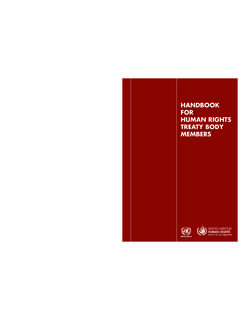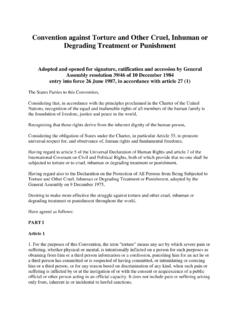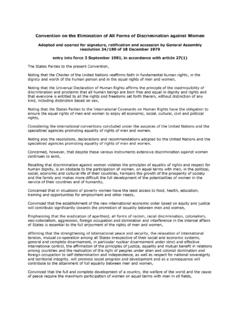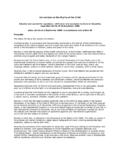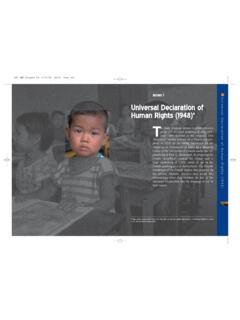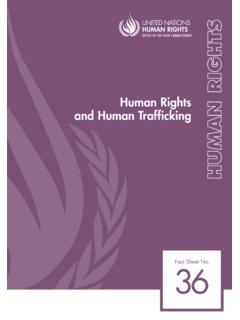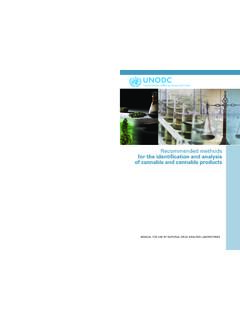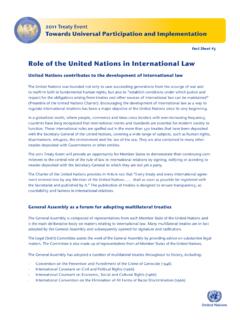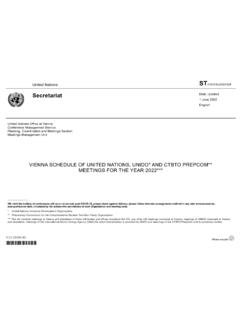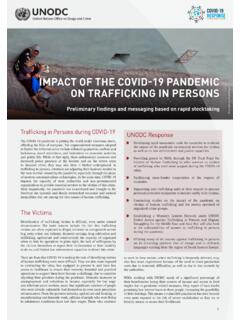Transcription of Use of Force and Firearms - Office of the United Nations ...
1 Resource book on the use of Force and Firearms in law enforcementCRIMINAL JUSTICE HANDBOOK SERIESOFFICE OF THE United Nations HIGH COMMISSIONER FOR HUMAN RIGHTSUNITED Nations Office ON DRUGS AND CRIMER esource book on the use of Force and Firearms in law enforcementUNITED NATIONSNew York, 2017 2017 United NationsThis work is available open access by complying with the Creative Commons licence created for inter-governmental organizations, available at must remove the original emblems from their edition and create a new cover design. Translations must bear the following disclaimer: The present work is an unofficial translation for which the publisher accepts full responsibility.
2 Publishers should e-mail the file of their edition to Photocopies and reproductions of excerpts are allowed with proper Nations publication issued by the United Nations Office on Drugs and crime (UNODC) and the Office of the United Nations High Commissioner for Human Rights (OHCHR). HR/PUB/17/6 (OHCHR)Cover photograph: iStock/kelvinjayPublishing production: English, Publishing and Library Section, United Nations Office at publication has not been formally description and classification of countries and territories in this publication and the arrangement of the material do not imply the expression of any opinion whatsoever on the part of the Secretariat of the United Nations concerning the legal status of any country, territory, city or area, or of its authorities, or concerning the delimitation of its frontiers or boundaries.
3 Or regarding its economic system or degree of resource book is the result of a joint effort by the United Nations Office on Drugs and crime (UNODC) and the Office of the United Nations High Commissioner for Human Rights (OHCHR), with the financial and substantive support of the Swiss Ministry of Foreign Affairs and the financial support of the Ministry of Foreign Affairs of Norway. The publication benefited from information gathered at an expert meeting held in Vienna in May 2015, as well as through two regional expert meetings organized by the Geneva Academy of International Humanitarian Law and Human Rights and UNODC, respectively in Buenos Aires, from 8 to 9 May 2014 and Tunis, from 26 to 28 January 2015.
4 The contributions received from the following experts are hereby acknowledged with appreciation: Otto Adang, Netherlands Police Academy; Stuart Casey-Maslen, Consultant to Professor Christof Heyns, University of Pretoria and former United Nations Special Rapporteur on extra-judicial, summary or arbitrary executions; Neil Corney, Omega Research Foundation; Milena Costas Trascasas, Consultant; Omer Fisher, OSCE Office for Democratic Institutions and Human Rights (ODHIR); Chris Graveson, Consultant; Robert Grinstead, Consultant; Hilarius (Lars) Huybrechts, International Committee of the Red Cross (ICRC); Neil Jarman, Institute for the Study of Conflict Transformation and Social Justice, Queen s University Belfast; Chair, OSCE Panel of Experts on Freedom of Peaceful Assembly; Tim Mairs, Police Service of Northern Island (PSNI); Simon Martin, Consultant, former police officer ( United Kingdom); Miriam Minder, Swiss Government; Ruth Montgomery, Consultant; Jacob Punnoose, India National Police; David Rosset, Office of the Police Commissioner, United Nations Mission in South Sudan; Matthew Sands, Legal adviser, Association for the Prevention of Torture.
5 Olafimihan Adeoye, Deputy Commissioner of Police (DCP) Operations, Nigerian Police Force , Awka-Anambra State HQ; Ignacio Cano, Coordinator Laboratory for the Analysis of Violence, State University Rio de Janeiro; Maja Daruwala, Commonwealth Human Rights Initiative (CHRI), New Delhi; Uladzimir Dzenisevich, Commonwealth Human Rights Initiative (CHRI), New Delhi; Hugo Fr hling, University of Chile; Roger Gaspar, Consultant, former police officer ( United Kingdom); Rachel Neild, Open Society Justice Initiative (OSJI); Vivienne O Connor, United States Institute of Peace (USIP); Ralph Price, Chicago Police Department; Darius Rejali, Reeds University; Colin Roberts, Universities Police Science Institute, former police officer ( United Kingdom); Ralph Roche, Human Rights Advisor, Police Service of Northern Island (PSNI); Josiane Somdata Tapsoba, Legal Officer, African Commission on Human and Peoples Rights (ACHPR) Secretariat, African Union Commission (AUC), and the International Network to Promote the Rule of Law (INPROL).
6 Special thanks and acknowledgement to Christof Heyns, former United Nations Special Rapporteur on extrajudicial, summary or arbitrary executions; Maina Kiai, former Special Rapporteur on the freedoms of peaceful assembly and of association; Manfred Nowak, former Special Rapporteur on torture and other cruel, inhuman or degrading treatment or punishment, and Eleanor Jenkins and Kathleen Hardy, consultants to the Special wishes to acknowledge the substantive contribution of Anneke Osse, as consultant. Contributing throughout the development of the resource book were UNODC staff Anna Giudice, Claudia Baroni, Johannes (Joop) de Haan, Mohamed Hassani, Philip Meissner, Piera Barzano, Simon Charters, Simone Heri, Ulrich Garms and Valerie Lebaux, with the support of UNODC interns Viviane Damoiseaux, Rouzbeh Mouradi and Rohan Sinha.
7 Further contributions came from Julien Chable, Hilarius (Lars) Huybrechts, Neil Davison (ICRC) and Mehdi Benchelah (UNESCO). On behalf of OHCHR, colleagues from the Rule of Law and Democracy Section were the main contributors.** The policy of OHCHR is not to attribute authorship of publications to iiiList of standards cited and acronyms used viiIntroduction 1 Key concepts and actors 1 PART I.
8 SETTING THE BOUNDARIES FOR THE USE OF Force IN LAW ENFORCEMENT 51. The international legal framework for use of Force in law enforcement International human rights law, United Nations Standards and Norms on crime Prevention and Criminal Justice and the use of Force From international law to day-to-day instructions Key human rights standards related to use of Force Rights and obligations: respect, protect, fulfil The obligations in practice: guiding principles for use of Force in law enforcement Use of Firearms 202. Human rights-based approach to law enforcement: legitimacy, non-discrimination and accountability Legitimacy: law enforcement by consent rather than Force Non-discrimination: providing fair law enforcement for all Scrutiny 36 PART II.
9 THE RESPONSIBILITY OF LAW ENFORCEMENT AUTHORITIES 413. Command and control The role of governments and law enforcement agencies in creating the conditions necessary for professional law enforcement An effective line of command Orders and obedience Planning for operations Creating a culture of professionalism and respect for human rights 504. Human resources management Recruitment, selection and promotion Training Performance management Early intervention systems 60 PART III. INSTRUMENTS OF Force 635. A range of means to allow for a differentiated response Introduction: apply non-violent means first A range of means Instruments of less-lethal Force How to decide when to use what type of Force ?
10 Use-of- Force models and matrices Protective gear, communication equipment and self-defence Procuring instruments of Force 74vi6. Guidance for the most commonly used instruments of Force in law enforcement General principles for all instruments Instruments of Force Control, storage, registration and issuance of instruments of Force 100 PART IV. POLICING SITUATIONS 1057. Public assemblies and protests Introduction Taking precaution: preventing the use of Force Use of Force during assemblies Allowing monitors and journalists Accountability after the event 1258. Criminal investigation Introduction Criminal investigation methods The suspect interview Measures to prevent coercion, ill-treatment and torture during a suspect interview 1329.
